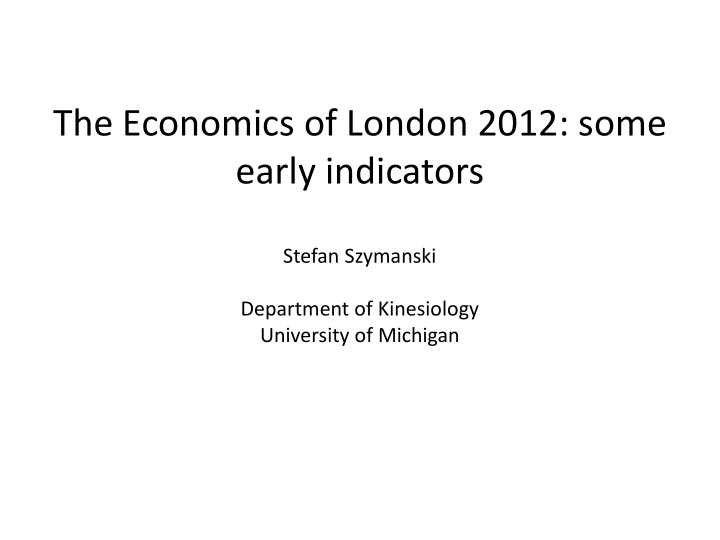



The Economics of London 2012: some early indicators Stefan Szymanski Department of Kinesiology University of Michigan
London’s Olympic commitments • From the outset, London put legacy at the heart of the bid and made an early commitment to delivering on key objectives • to make London a world-leading sporting nation • to transform the heart of East London • to inspire a generation of young people • to make the Olympic Park a blueprint for sustainable living • to demonstrate the UK is a creative, inclusive and welcoming place to live in, visit and for business.
East London and Olympic Park legacy • Classic inner city blight- decline of traditional industries • Poor communication links • Low quality housing stock • Low quality services- health and education • Poorly qualified workforce, low employment • Social problems • High population turnover- inward and outward migration
The scale of the problem • The population of East London is around 2 million • East London covers of around over 500 sq. kilometres (depending on definition) • The Olympic Park covers an area of about 2.5 sq. kilometres • Employment in the Olympic Park is expected to be around 8-10,000; it is expected to provide 11,000 new homes
Olympic site
118.4 147.6 101.6 96.1 97.4 112.3 107.0 124.7 103.9 128.4 122.3 97.7 67.1 96.1 97.8 141.4 113.3 81.4 139.6 101.1 82.0 110.4 151.9 103.5 163.7 90.7 126.3 104.4 81.8 149.2 167.5 Employment levels by 98.8 London Borough
1440 1702 2013 3248 2509 1991 953 1078 5451 7689 5610 6575 1859 2653 4947 6607 5275 5000 6711 4839 2114 1972 5664 1709 4778 1580 3593 2776 2196 994 Employment per 1936 2253 square kilometre
Average annual Average annual growth rate of growth rate of Borough employment 2000- employment 2005- Growth rates 2010 2010 Hackney (host) 2.91 5.66 of Tower Hamlets (host) 2.42 4.39 Southwark 2.60 3.31 Lambeth 2.64 3.15 employment Camden 3.83 3.04 Islington 2.68 2.63 Hounslow 1.20 1.70 in London Westminster 3.94 1.53 Richmond upon Thames 1.78 1.47 Wandsworth 1.80 1.47 boroughs Brent 0.93 1.40 Sutton 0.18 1.35 Merton 0.84 1.17 Kingston upon Thames 1.86 1.11 Barking and Dagenham 0.17 1.05 Waltham Forest (host) 0.14 0.97 Greenwich (host) 0.85 0.86 Hillingdon 0.47 0.80 Kensington and Chelsea 2.76 0.75 Newham (host) 1.48 0.74 Bromley 0.86 0.66 Croydon 1.04 0.48 Barnet 0.04 0.20 Harrow 0.46 0.16 Havering -0.28 0.15 Lewisham 1.48 0.02 Haringey 0.44 -0.21 Hammersmith and Fulham 1.45 -0.27 Redbridge 0.48 -0.59 Bexley 0.34 -0.72 Enfield 0.12 -0.78 Ealing 1.00 -1.03 Non-Host London borough 1.25 0.88 Host boroughs 1.52 2.44
Changes in employment by sector 2005-2010 Tower Waltham Non-host Greenwich Hackney Newham host Hamlets Forest boroughs Total 21,300 59,600 27,000 57,300 33,200 198,400 450,500 Manufacturing -5,000 -6,600 -2,300 6,900 3,100 -3,900 -15,500 Construction -16,200 -5,000 6,800 -1,900 7,000 -9,300 69,000 Distribution, hotels and restaurants 9,700 4,300 6,600 -3,200 12,500 29,900 -148,400 Transport and communications 8,800 -1,200 -9,400 1,500 -14,400 -14,700 -21,000 Banking, finance and insurance 36,200 32,300 9,500 29,400 -14,700 92,700 290,900 Public administration, education and health -13,700 29,000 18,300 29,600 24,800 88,000 185,600 Other services 4,500 -900 -6,400 -3,300 5,900 -200 14,000
Pre-games estimate of impact? • Infrastructure will raise the level of amenities • Buyers in the housing market will anticipate effects • Kavetsos (2009) examined the impact of the Olympic announcement on property prices • Estimates derived for properties in concentric rings around the Olympic site
+5% +2% +2.2% Impact on property 6 miles prices 12 miles Source: Kavetsos (2009) 18 miles
Impact on property Economic value of prices and the host impact = £1.4 billion boroughs Source: Kavetsos (2009)
Recommend
More recommend